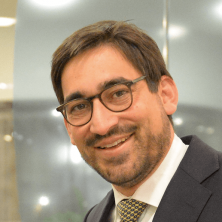As the Russian war against Ukraine rages in its fifth month and countless lives have been lost, damages to civilian infrastructure have also reached a staggering toll of over USD 100 bn according to the June 8, 2022, Kyiv School of Economics damage assessment. Over 10% of those damages relate to industrial enterprises, about 30% concern roads and infrastructure and almost 40% relate to residential buildings. In addition, at least 270 thousand km2 of land require demining according to the Ministry of Internal Affairs. Ukraine, with support from the international community, will have to undertake a massive effort to reconstruct damaged or fully destroyed civilian infrastructure and restore its agricultural and natural land.
While the fight to liberate Ukrainian territory continues, discussions on the reconstruction process have already begun and several proposals have already been circulated by various organisations and stakeholders (for example CEPR, CMU, NRC). Although each proposal for a reconstruction programme contains references to a “green reconstruction”, plans have so far been relatively vague on the precise meaning of this term. In our previous article, we have argued that a green reconstruction is not a luxury but an economic necessity to ensure the survival and competitiveness of Ukraine’s economy.
In order to advance the discussion from the recent Lugano conference, the necessary transformations and technology options for each sector, as well as the key barriers and appropriate policies for realising a green reconstruction now need to be identified. Against this backdrop, Low Carbon Ukraine, together with Centre for Environmental Initiatives “Ecoaction” and CEE Bankwatch, have organised a roundtable conference on May 31st. This roundtable brought together over 60 representatives from civil society and industry, as well as national and international experts, to discuss what green reconstruction means concretely in every sector, what barriers to a green reconstruction currently exist, and how an optimal policy mix could overcome these barriers. This article reflects the insights the organisers gained from the conference. A long version of this article is available at Low Carbon Ukraine.
Overarching conclusions
Several overarching themes emerged as crucial to a robust and successful green reconstruction.
- Implementing green reconstruction requires a combination of programme design and policy: Green reconstruction must be implemented in several sectors by a multitude of actors. To ensure that decentralised decision-making is guided towards green reconstruction requires overcoming existing obstacles to green investment (for example unfavourable market regulation in the electricity sector, subsidised consumer tariffs for largely fossil-based heat, and the public service obligation scheme on electricity for households) to be eliminated. In that context, wasteful direct and indirect price subsidies should be replaced by usage-independent and more targeted subsidies to vulnerable consumers. At the same time, the reconstruction programme itself must be designed to encourage prioritising the long-term, lifetime efficiency of green technologies and project investments over generally higher initial investment costs. Where coordination problems between and within sectors may emerge (for example on electrification of the economy), programme design may have to become more interventionist and specific to overcome market failure.
- A strategic decision is required regarding whether to make Ukraine a showcase model for selected frontier technologies. Many of the technologies needed for a truly green reconstruction are already widely in use and commercially efficient. But in some cases (for example green steel or cement production, heat pumps), green technologies are in earlier stages of deployment. While a reconstruction using some of these frontier green technologies would be comparatively costly, reconstructing with old technology would risk creating stranded assets in the future (for example when subject to stringent EU rules and prices for Greenhouse Gas (GHG) emissions). For these areas, a strategic decision by Ukraine and its international partners will be required to determine if Ukraine could indeed become a showcase country for modern technologies. This would also require coordination with other sectors, as it would most likely imply substantially faster electrification of the economy and the need for renewables-based hydrogen availability in the longer term, for example in industry.
- Affordable financing is vital for green reconstruction: As the costs of capital were already high in Ukraine before the war and will not improve after the war ends, access to affordable financing for investments will be vital. Otherwise, the higher capital costs of green investments cannot be outweighed by lower operational costs. Affordable financing could be provided by international financial assistance through discounted credit or grants, probably in the context of a post-war reconstruction programme as proposed by the EU. In particular, the Ukrainian government together with international financial institutions should ensure access to affordable funding for small- and medium-sized enterprises.
- Efficient administration of green reconstruction projects is necessary to secure speedy implementation: Replacing old, dirty and inefficient assets which are damaged or destroyed by the war with newer and clean technologies will generally require more sophisticated planning and construction processes that can otherwise lead to a lower speed of implementation. To avoid stalling or impeding the green reconstruction, effective and fast project management and implementation processes are needed. At the same time, authorities and investors should guarantee access to projects’ information including meaningful public participation compliant with the Aarhus Convention. For project appraisal on a local scale, for example, innovative mechanisms involving the local population such as participatory budgets might be considered.
- Governance of reconstruction programmes and a continuation of reform processes are required to attract financing. Ukraine’s international partners, especially the EU and USA, declared their willingness to substantially assist Ukraine’s post-war reconstruction. Still, Ukraine will need to provide the conditions to allow this investment to take place. Most notably, the actual reconstruction programme vehicles need to reflect international best practice in governance. Anti-corruption, rule of law efforts (i.e., judicial and police reforms), protection of human rights and other reforms, many of which were not showing much progress in the period preceding the war, need to be restarted with redoubled effort, also in view of recent positive legislative developments and requirements for EU membership. While the donors are expected to coordinate their reconstruction efforts, Ukrainian authorities are expected to transparently provide the information on the funds they’ll receive and improve their accountability, involving the community in decision-making, and facilitating access to information. Transparency and accountability are necessary across the wider value chain, including in amongst others, government procurement, public financial management and investment decisions. Good governance must be ensured out of respect for the millions of Ukrainians suffering incredible hardship for their dream of a sovereign country free from corruption.
- International private investment will require political risk insurance. The potential role of international private investment should not be overlooked. Private investment could complement and enhance the financing provided by countries and international financial institutions. It would benefit Ukraine to improve productivity through joint ventures or create competition on previously monopolistic markets. However, private investors will be very cautious in a post-war situation, with security concerns likely not fully resolved for years to come. The availability of investment insurance, covering relevant risk categories such as military risk, would be a necessary precondition to attract any such investment. As it would reduce the need for financial assistance from public budgets, the provision of investment insurance should be a win-win for international partners. It could be especially useful if provided at a larger scale, for example, by the EU, to avoid a multitude of different bilateral investment insurance schemes. Potentially, frozen Russian assets could be used as collateral for such risk insurance.
- Green post-war reconstruction of the country cannot happen without ensuring restoration of damaged ecosystem services. Returning life to the previously occupied territories means not only physical rebuilding of infrastructure but also providing people and nature with basic natural resources to flourish on: clean water, air, and healthy soil. Moreover, achieving the pan-European goal of climate neutrality by mid-century is almost impossible without carbon sequestration and storage by carbon sinks (forests, peatlands, soil storage). All these cannot be achieved without building a climate resilient and nature-positive economy in Ukraine as a long-term vision for development. To achieve this goal, efforts must be undertaken to expand protected areas to at least 20% of terrestrial land and at least 10% of aquatic land through conservation and restoration in the next decade. This includes various regimes of protection and use, including highly protected reserves and national parks and Emerald network lands with limited use. Damaged soil ecosystems, difficult-to-remediate chemical pollution and the high costs of agricultural land restoration after hostilities make the decision on granting the protection status to such territories the default and cheapest option. Among important steps toward building a nature-positive economy are the restoration of degraded hayfields and pastures, flooding of drained wetlands, preservation of self-seeding forests and wetlands, and wide-spread application of nature–based solutions in urban planning during reconstruction of cities.
To allow a consistent integration of the above considerations, there is a strong need for Ukraine and its partners to agree on a basic architecture of the reconstruction programme as soon as possible. While the European Commission’s recent communication did outline an initial and preliminary structure including joint Ukrainian and EU political governance over a multitude of actual financing instruments and institutions, the structure of these institutions and their mode of operation remains unclear. To allow more constructive debate on programming and policy, this should be addressed as early as possible. Ideally, joint Ukrainian and EU political ownership should be coupled with the EU’s expertise in handling large-scale financial programmes. At implementation level, existing project management capacities, for example of international development banks active in Ukraine should be utilized and successful models such as the Energy Efficiency Fund should be used as a blueprint for designing necessary additional institutions. The European Code of Conduct on Partnership should be followed to ensure the involvement of all stakeholders, including civil society organisations and municipalities in all stages of decision-making and implementation.
Outlook
It becomes clear that planning for a Green Reconstruction of Ukraine is a multifaceted challenge that demands policy coordination across a multitude of domestic and international actors. This requires a well-designed overarching institutional framework which needs to be developed as soon as possible by Ukraine together with its international partners.
While there are good economic reasons to build back greener, a number of obstacles from strategy, policy design and implementation, financing and risk insurance, administrative efficiency, and redoubled reform implementation need to be overcome. Important strategic decisions need to be taken at the highest political levels such as turning Ukraine into a showcase for selected frontier technologies, becoming a producer of technologies instead of raw material exporter and dedicating a share of militarily affected and polluted land to nature conservation. Sectoral policy design and implementation will require further elaboration and discussion, for which the above sections might provide a first starting point.
Meanwhile, Ukraine needs to develop a clear vision for its reconstruction in terms of the priorities and desired transformations. In other words, Ukrainians need to come together and decide which kind of country will be rebuilt. As our roundtable conference has shown, and as we have attempted to outline here, many concrete ideas for an economically-sound, environmentally-friendly and socially-just green reconstruction exist. Today’s fight is for the liberty of the Ukrainian land and people. Tomorrow, we should all strive to rebuild a more liveable, greener, and more climate-resilient Ukraine.
Authors: David Saha, Rouven Stubbe, Pavel Bilek, Anna Ackermann, Anna Danyliak, Viktoriia-Anna Oliinyk
Attention
The authors do not work for, consult to, own shares in or receive funding from any company or organization that would benefit from this article, and have no relevant affiliations





